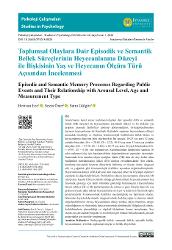| dc.contributor.author | Ece, Berivan | |
| dc.contributor.author | Öner, Sezin | |
| dc.contributor.author | Gulgoz, Sami | |
| dc.date.accessioned | 2020-06-04T17:06:36Z | |
| dc.date.available | 2020-06-04T17:06:36Z | |
| dc.date.issued | 2020 | |
| dc.identifier.issn | 1304-4680 | en_US |
| dc.identifier.issn | 2602-2982 | en_US |
| dc.identifier.uri | https://hdl.handle.net/20.500.12469/2881 | |
| dc.identifier.uri | https://doi.org/10.26650/SP2018-0028 | |
| dc.identifier.uri | https://search.trdizin.gov.tr/yayin/detay/357991 | |
| dc.description.abstract | The major aims of the study were to investigate (1) the potential differences in arousal levels for episodic (EM) and semantic memory (SM) processes regarding public events and the comparison of these differences for different age groups, (2) the consistency of self-report versus objective measures of arousal, and (3) phenomenological characteristics of the events as function of memory type and arousal level. The sample consisted of 32 young adults whose ages ranged between 18 and 25 years (M = 20.60, SD = 2.22), 33 middle-aged adults aged between 40 and 55 years (M = 47.32, SD = 6.60), and 30 elderly people aged between 60 and 75 years (M = 69.97, SD = 6.16). Participants were asked to make a remember/know judgment for the 10 public events presented to them. They further answered event-related questions (SM) and questions regarding the context of hearing about the event (EM). Moreover, they reported their arousal level during recall and evaluated each event in terms of phenomenological characteristics such as importance, emotional intensity, and valence. Arousal level was also measured using physiological measurements with the GSR device. Based on self-reports, EM processes were associated with higher arousal levels compared to SM processes whereas the five physiological indicators of arousal displayed different patterns. Both EM and SM performance displayed an increase together with the increasing arousal levels, and young participants displayed higher levels of arousal and faster physiological responses than both middle-aged and elderly adults. When phenomenological characteristics were examined, remembered public events were rated more important, emotionally more intense and more negative than known events. Furthermore, higher arousal levels were associated with higher ratings of emotional intensity, importance and negativity. The reliability of self-reports and the critical role of applying objective measures were discussed together with the findings. Finally, some suggestions were proposed for future research on the basis of the current limitations and results. | en_US |
| dc.language.iso | tur | en_US |
| dc.publisher | Istanbul Univ | en_US |
| dc.rights | info:eu-repo/semantics/openAccess | en_US |
| dc.subject | Autobiographical memory | en_US |
| dc.subject | Semantic memory | en_US |
| dc.subject | Episodic memory | en_US |
| dc.subject | Arousal and memory | en_US |
| dc.subject | Public events memories | en_US |
| dc.subject | Flashbulb memory | en_US |
| dc.title | Toplumsal Olaylara Dair Episodik ve Semantik Bellek Süreçlerinin Heyecanlanma Düzeyi ile İlişkisinin Yaş ve Heyecanın Ölçüm Türü Açısından İncelenmesi | en_US |
| dc.title.alternative | Episodic and Semantic Memory Processes Regarding Public Events and Their Relationship with Arousal Level, Age and Measurement Type | en_US |
| dc.type | article | en_US |
| dc.identifier.startpage | 247 | en_US |
| dc.identifier.endpage | 283 | en_US |
| dc.relation.journal | Studies in Psychology-Psikoloji Çalişmaları Dergisi | en_US |
| dc.identifier.issue | 1 | en_US |
| dc.identifier.volume | 40 | en_US |
| dc.department | Fakülteler, İktisadi, İdari ve Sosyal Bilimler Fakültesi, Psikoloji Bölümü | en_US |
| dc.identifier.wos | WOS:000533602900010 | en_US |
| dc.identifier.doi | 10.26650/SP2018-0028 | en_US |
| dc.institutionauthor | Öner, Sezin | en_US |
| dc.relation.publicationcategory | Makale - Uluslararası Hakemli Dergi - Kurum Öğretim Elemanı | en_US |
| dc.identifier.trdizinid | 357991 | en_US |
















